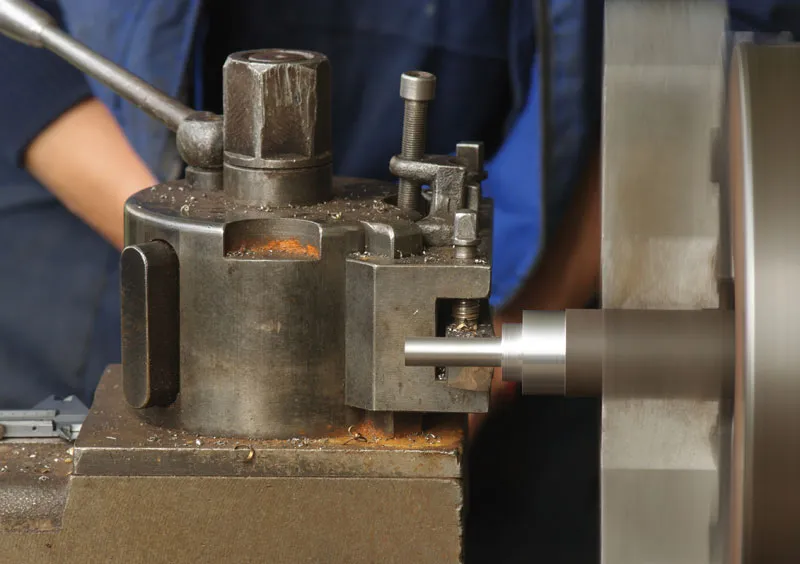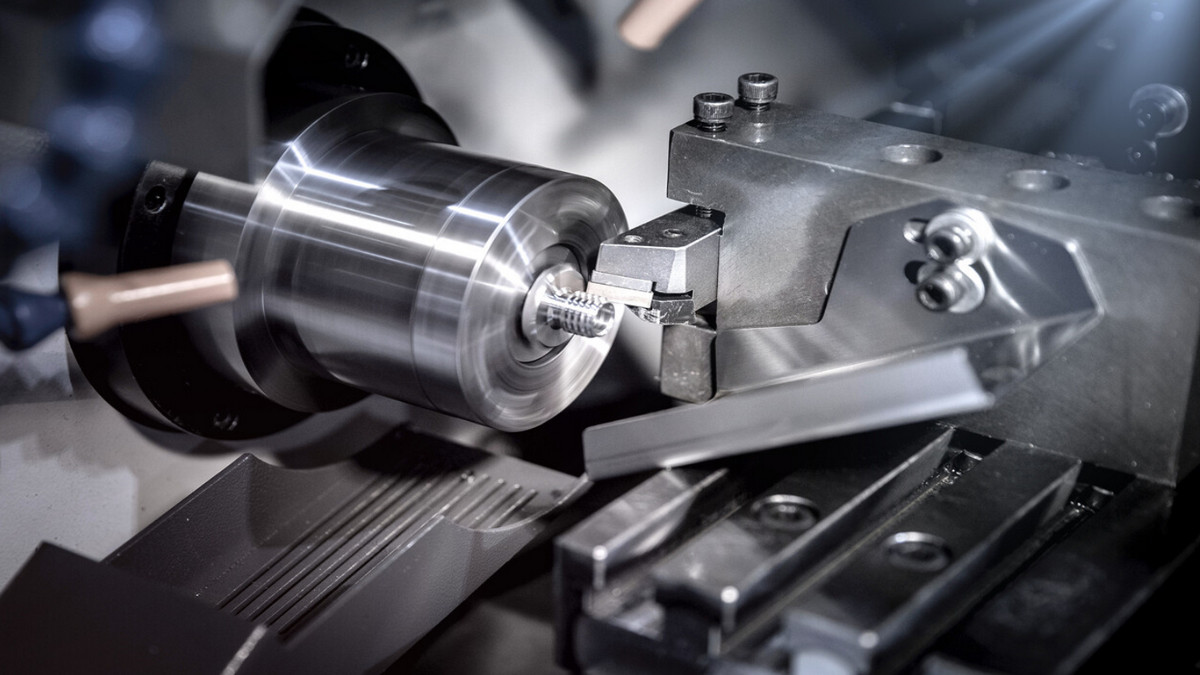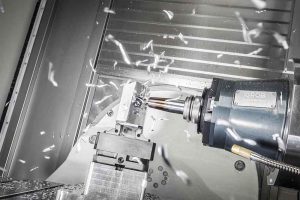Horizontal milling machines excel in heavy-duty tasks with their robust spindle design, efficient chip management, and multi-cutter simultaneous operation
Spindle Orientation and Design
Spindle orientation in horizontal milling machines is a fundamental feature that defines them as such and affects their use in different manufacturing contexts. Horizontal milling machines, as opposed to their vertical counterparts, have spindles in a horizontal position. The spindle holds the cutting tool and rotates over the workpiece’s top, allowing the same to be side-milled. Thus, the process of milling is rather effective when working on large and heavy workpieces. On the negative side, the use of side mills limits the machine’s application to machining operations. A horizontal spindle orientation is recommended for jobs that demand heavy material removal, such as dovetail milling or machining complex shapes. Such orientation has several advantages:
-
Increased stability: the horizontal spindle orientation spreads the cutting force over a broader area, so the force is smaller and better absorbed. As a result, the vibration tends to be considerably reduced, allowing heavier cuts to be made.
Horizontal Spindle Specifications and Capabilities
The spindle design ensures that it can endure the high torque and forces arising in heavy and often rough milling jobs. A brief listing of horizontal spindle features is as follows:
-
High torque output – horizontal spindles’ high torque output helps when cutting hard materials, such as titanium. Some older machine models offer up to 1,000 Nm of spindle torque.
Spindle Speed
Although faster, the spindle speed features practically the same range of values as previously-described vertical machine counterparts. The same rather small ranges apply to horizontal machine spindles, which generally offers at 35 RPM speeds up to around 3,000. Overall, the spindle speed is lower because the horizontal machine is efficient when used on the large and heavy workpieces, hence cutting mainly tough and challenging to machine materials. In order to accommodate corresponding cutting speeds, horizontals spindles’ low-end speeds values are that low. The spindles are supported using high-quality bearings, yet some manufacturers opt for the short power-operated spindle. The spindle’s durability and performance are further guaranteed by it being built from high-quality steel and rigorously machined. For example, in horizontal mills by Haas or Mazak, the spindle is fitted with heat-treated and ground gears. Some machines have internal cooling systems, while others are equipped with a sensor that monitors the spindle load.

Tool Holding and Change Capabilities
Holding and change capabilities are a crucial aspect of the operation of horizontal milling machines, influencing the versatility and efficiency of the milling process. The critical components used to hold the tools in these machines are built to resist the strong forces used during milling. The majority of modern horizontal mills use a CAT/BT, HSK, or an alternative taper design that allows for precise and secure clamping of the tool, allowing for high precision and heavy-duty cutting operations.
-
CAT/BT Taper: widely used sturdy and precise taper in standard milling operations.
-
HSK Taper: a more superior taper form that uses a hollow shank to improve precision, an ideal feature for high-speed applications.
The most common type of these tools, the CAT tool holder, offers a solid and reliable fit for the tool. These machines also commonly use Automatic Tool Changers, which provide substantial operational efficiency improvements. These devices may hold in excess of 20 tools and can automatically switch between them during machine operation. For instance, the a61nx horizontal machining center designed by Makino has a 60-tool magazine, with an option to increase it to 313 tools.
-
High Precision: High-end CAT and HSK tool holders, and precise automatic tool changers that can operate on sub-second scales.
-
Tool Life Management: Tool wear-monitoring and automatic tool changing systems to prevent poor quality.
Their operation is heavily dependent on the rate at which the tool changes occur. In some cases, the device in question can automatically change tools within 2.5 seconds. Such quick changes are made possible by complicated mechanical systems and precise control software that can produce very rapid spindle-shifts and tool motions. These technologies are not just to keep the tool in the machine or switch to a new one but are designed to enhance the entire operation of the machines. Tool life management systems are commonly integrated into milling machines’ CNC software. This allows the machine to take a measurement and replace the tool if it goes beyond the maximum size specified. Since such tools frequently break suddenly and without warning, as well as the fact that their diameter seriously affects the quality of the finish, these systems help increase untended operation running times.
Axis Movement and Control
Horizontal milling machines are among the best due to their precise and dynamic movement along all axes. When performing a wide array of complex and varied tasks, especially for large and heavy pieces, movement along the X, Y, and Z axes is required. Some milling models perform better with additional axes, hence higher precision and variety. In fact, the efficiency and performance of both horizontal and vertical milling machines are graded based on these parameters. Some of the leading features that allow them to perform their functions as expected include:
Precision and Range of Movement
The axis system is essentially designed and purposefully made to meet the demands of such machines that can handle both large scale and fine dimensional work. Ideally, the X- and Y-systems possess the following approximate or minimal features:
- X-axis Travel: Horizontal milling machines may have over 600mm to more than 3,000mm X with regards to traveling, ensuring the milling of wide and long workpieces. Some systems, such as the Mazak brand, incorporate the use of a roller guide, which is better in regards to rigidity and positional accuracy than the traditional ball guides.
- Y-axis Travel: Usually slightly reduced distance than the X-axis, which is adequate for a wide array of applications. The latter range is 400mm to around 2,500mm, while the repeatable maximums are 2,000mm.
- Z-axis Travel: Essential for depth control, being approximately 400mm to 2,000mm.
Both axes feature high-precision ball screws, linear guides, teeth, and cones to enhance movement accuracy, ultimately reducing backlash. As a result, smoother movement and precision are promoted.
Speed and Feed Rates
The attribution is vital due to productivity-related issues, including tool life and efficiency of machining. As a result, they can travel at:
- Feed Rates: Up to 60 meters per minute, with the actual distance being dependent on the quality of the controller and drive system.
- Rapid Traverse Rates: Up to 100 ms per minute, ultimately reducing the non-cutting time.
Advanced Control Systems
The newly developed models consist of CNC (Computer Numerical Control) high-end systems that facilitate increased precision in all movements. These systems aid in:
- Automation of Complex Processes: Such systems are purposely designed to perform complex milling operations, an attribute that includes changes of direction and speed at intervals. They are purposely designed for high-resolution encoders in each and every of the existing axes to reach high precision, ultimately leading at achieving the tight tolerance.
Integration of Automation and Feedback
Such models are equipped with advanced sensors or rather systems that detect conditions or rather how the milling process is carried out live, ultimately making adjustments to meet demands. Such include:
- Automatic Correction: In the horizontal milling machines, there exist corrective measures where the axes move dynamically hence falling back into line together with the perfect path of the tool. Tool condition monitoring.
Power and Speed Range
Relatively high power and a decent speed range are two essential characteristics of horizontal milling machines when it comes to their design for demanding applications. A combination of these capabilities is crucial in the machining of different materials and achieving both rapid material removal and fine finishes.
Engine Power and Capabilities
The engine power in horizontal milling machines is customized for high torque requirements and maintaining extended operation periods without overheating or losing efficiency. Consequently, the power range for these machines is approximately:
- Low-end Models: About 15 kW, as they are not designed for heavy machining of hard materials.
- High-end Industrial Models: Up to 50 kW or more, as they can be used for titanium and hardened steel.
The high end of this range is useful when precise dimensions have to be achieved on the finished product, and the spindle has to maintain a stable speed under load.
Speed Range and Adjustability
The vast majority of horizontal milling machines feature remarkable speed ranges because of the diversity of materials they have to accommodate. However, these machines are also equipped with:
- Variable Speed Settings: The user can set the spindle speed according to the material properties and the tooling requirements.
- Typical Speed Range: Between about 35 revolutions per minute and 3,000 or more Revolutions Per Minute sets for heavy and finishing cuts, respectively.
Integration of Advanced Drive Systems
Modern horizontal milling machines feature advanced drive systems that are crucial for their optimal speed capabilities and operational flexibility. These systems include:
- AC Induction Motors: Stall torque is superior to that of servomotors.
- Vector Drives: Speed control is very precise, and they offer high mechanical power at low speeds for difficult-to-machine metals.
Application-Specific Speed Features
Horizontal milling machines are customized to support specific applications to ensure the best possible results. A few of these speed-related features include gearboxes with:
- Multiple Speed Ranges: Offering three options to run the machine effectively under different loads and conditions.
- Program Speed Control: Supported by advanced CNC systems, adjusting to optimize cutting conditions.
Machine Size and Weight
In the context of horizontal milling machines, their size and weight are among the crucial parameters that determine their functionality and applicability for specific industrial tasks. Specifically, their mass and dimensions define their stability, which can be required for performing some heavy-duty tasks in such industries as aerospace or automotive.
Typical Scale and Dimensions
The size of a horizontal mill largely depends on its purpose and, correspondingly, the required capacity. Generally, it implies the following :
- Small to Medium Machines: Usually equal to approximately 2 meters in width and 2 to 3 meters in depth, these sizes are appropriate for small and medium-sized production facilities and tasks that do not require as much space.
- Large industrial machines: for manufacturing of heavy-duty components of various scales, these can be more than 5 meters wide and 10 meters and more in length, depending on the size of the component.
Effect of Weight on Stability
The weight of a horizontal mill plays a crucial role in its stability, which is essential for precision machining. Typically, it depends on the scale of the machine and the materials used for its construction:
- Lighter machines: for relatively lightweight machining applications, such mills can weigh around 5,000 kg depending on the size and scale of the machine.
- Heavier industrial models: in some cases, they can exceed 20,000 kg, which can be required for heavy-duty machining that can hardly be performed on a lighter machine without loss of precision and performance.
Impact of Size and Mass on Performance
Both the size and the weight of a horizontal milling machine affect its performance positively in several ways:
- Increased stability: larger and heavier machines are less prone to vibrations, which is vital for high-precision machining. It is especially true for some operations that would fail if a machine experiences even minor vibrations.
- Larger workpieces: in terms of physical capacity, any horizontal mill is limited in sizes of workpieces that can be handled, so small-sized machines have limitations in terms of scale of components that can be milled.
Safety Features
Safety features in horizontal milling machines are critical subsystems that protect the operator and improve the overall safety of the manufacturing setting. They are incorporated into the design of the machine and are present at every step. International safety standards are taken into account and the chances of an accident occurring during operation is almost entirely eliminated.
Emergency Stop Buttons
These are located all over the machine with easy access. They are located right on the panel for the operator and will shut down all operations of the machine immediately. This prevents extremely serious injuries when it comes to unexpected events, or if any part of the machine is malfunctioning.
Safety Guards and Shields
Physical barriers, known as guards and shields, are needed:
-
Enclosures: The area of milling is fully enclosed. Chips and coolant spray are not allowed to escape. It is dangerous for it to do so.
-
Transparent Shields: Operators can view the machining process as a barrier will protect the eyes from any debris that could fly off of the workpiece. This will not impair the line of sight for the operators.
Safety Interlocks
Interlocks ensure that the machine will not perform an unsafe operation:
-
Door interlocks ensure that the doors of the machine are properly closed before it will operate.
-
Tool change interlocks ensure that the spindle will not start if the tool change is not properly completed.
-
Tilt interlocks ensure that the spindle and the tool holder are locked properly in place before starting the operation.
Spindle Locks
Spindle lock is ensured that the spindle will not start to move as the operators are setting up the machine. It will also not start as the operators try to replace the old tool with a new one. Accidental activation will not be possible.
Automated Monitoring Systems
Modern horizontal milling machines have sensors and monitoring equipment that run automated monitoring software to ensure the safety of the operations:
-
Overload sensors will shut down all operations if the machine, or a specific implementation of the machine is performing beyond its role or capacity. This will prevent damage and accidents from occurring.
-
Temperature monitoring will inform the operators of the temperature of the spindle and machines and inform about failing parts or upcoming fires.
Fire Suppression Systems
In environments where the chances of fire are high due to the types of materials that are being machined is high, for the fluids or coolants being used, integrated fire suppression systems are used. These coverage all areas of the inner machine enclosure and can detect and start extinguishing fires without any human intervention.
Operator Training and Manuals
Training programs are always developed for operators as safety features are only effective when they are properly trained and know the machine. All programs should include safety features:
-
Training Programs outline all safety features and mention all the right way to operate the machine.
-
Manuals are available to the operators at all times. They include troubleshooting guides, and what to do in case of an emergency.

Software and Automation Options
Horizontal milling machines are increasingly equipped with software and automation options that improve their precision, efficiency, and overall usability. These features are essential for modern manufacturing settings, where speed, repeatability, and limited time spent on downtime are paramount. At the core of modern horizontal milling machines is the CNC system, which allows for precise control over machine’s operations. In this type of systems, operations are programmed, which allows for:
-
Programmable operations: users can input exact definitions of the machine’s movements, speeds, and feeds, and can be sure that they will be executed to the same specification every time they run.
-
Complex machining programs: due to the degree of separation between the user and the operation, the CNC systems can easily handle sequences that would be impractical with manual means.
As a result of the widespread availability of CNC systems, there are several standard software features that can be found in the software of most machines, including:
-
Real-time data: many systems provide users with data informing about the device’s operation. Additionally, if the machine registers that the series of operations currently programmed can be improved, it may suggest changes in these parameters.
-
Simulation: before committing to the actual machining of a part, users can run simulations of such processes on the CNC, which would not only inform the user about the machine’s expected behavior but also about potential errors in the machining process to eliminate material waste and prevent machine crashes.
Automation of various machine capabilities can similarly be found in advanced systems. For example, in automatic tool changers , multiple tools are stored within the machine and are switched out on software command. In an automated pallet changer system, workpieces are automatically swapped to reduce downtime between operations. Data connectivity and IoT systems are also common in modern machines, with remote monitoring and various other software-powered features, such as predictive maintenance through predictive algorithms. Simple user interfaces are also standard, often utilizing touchscreen panels, and, in many cases, these interfaces are customizable. Finally, as software becomes increasingly integrated into machining, security features to keep unauthorized personnel from using the machines and to prevent data breaches have also become increasingly important, with solutions including access controls and data encryption.









